Welcome to Your New Gym!
A Living Book
This website is inspired by books like “Patterns for Jazz” and “Pumping Nylon”—beneficial books designed to increase a musician’s proficiency on their instrument. “Patterns for Jazz” is intended for any melodic instrument, rather than a specific one, and “Pumping Nylon” focuses on building proficiency and getting a workout on your classical guitar. The intention of this website lies somewhere in the middle, focusing on developing musicians’ improvisational skills.
I thought of the term “living book” because it’s living in the sense of being unfinished and having no finite end, which I suppose can be said of many websites and courses, but also because, if you subscribe, you can interact with it.
I’ll develop the general content for all instruments first, with modules for Treble and Bass Clefs. Then I’ll start adding some instrument-specific content.
This website is free to use once you register(the “Free Weights). Each exercise will also have a file you can play right from the browser. This notation player offers many tools to help you progress, especially the speed trainer. To access the player (the Machines), you will need a subscription, which I’m testing on a pay-what-you-want (PWYW) basis.
Below is an example of what is offered here:
Major Scales
For the playable examples, I’ve included two lines for the treble clef (one concert and one that transposes an octave lower than written), and three lines for the bass clef (Bass in concert, Contrabass in concert, and Contrabass that transposes an octave lower than written). Regardless, you can and should play in any octave that’s initially comfortable for you and later becomes a challenge, according to your instrument and abilities. This also trains your ear to hear octaves.
Experiment with the player’s controls.
The goal should be to play through without stopping, then increase speed. Try it with the speed trainer and set it to increase by small increments—2 beats or so per repeat. You can also use the Speed Trainer with the Loop function to isolate each scale.
Note to guitarists and electric bassists: Overall, reading notation is better for developing musicality; this is especially true of improvising. There is so much to learn and intuitively gain from finding the notes and figuring out fingerings that are robbed from you by reading tablature. Tablature is great for learning tunes. Keep using it for that.
Note to transposing instrumentalists: improvising requires you to transpose into the relative concert key. You’ll need to figure out what to play to match the playable examples, if you don’t mind. If you’re not a subscriber, I strongly suggest you play the exercises in concert pitch.
The "Free Weights" are all always Free!

Try the "Machines" for Free!
The "Free Weights" are all always Free!

